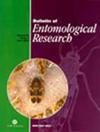Impact of Aphis pomi-tending Formica rufa (Hymenoptera: Formicidae) on biological parameters of Hippodamia variegata (Coleoptera: Coccinellidae)
IF 1.6
3区 农林科学
Q2 ENTOMOLOGY
引用次数: 0
Abstract
One of the key reasons for the poor performance of natural enemies of honeydew-producing insect pests is mutualism between ants and some aphid species. The findings demonstrated that red wood ant,蚜虫(膜翅目: Formicidae)对海马(鞘翅目: Coccinellidae)生物参数的影响
蚂蚁与某些蚜虫物种之间的互作关系是导致产蜜害虫的天敌表现不佳的关键原因之一。研究结果表明,红木蚁 Formica rufa Linnaeus(膜翅目:蚁科)对瓢虫 Hippodamia variegata Goeze(鞘翅目:茧蜂科)的不同生物参数有有害影响。变节瓢虫在有蚂蚁照料的蚜虫群落中产卵量要少得多,而在没有蚂蚁的情况下产卵量要多出近 2.5 倍。蚂蚁会触角和咬瓢虫卵,导致卵孵化率明显降低,只有 66%,而没有蚂蚁的处理则为 85%。蚂蚁的存在大大降低了所有幼虫龄期的发育。第四龄幼虫的发育速度下降幅度最大(31.33%),第一龄幼虫的发育速度下降幅度最小(20%)。与早期幼虫相比,晚期幼虫受到的蚂蚁攻击更为猛烈。第一和第二龄幼虫在蚂蚁的攻击下停止了进食和活动。第三和第四龄幼虫改变了它们的活动能力,导致蚂蚁对它们的攻击性增加。研究表明,瓢虫成虫比幼虫更容易受到蚂蚁的攻击。然而,H. variegata成虫在面对F. rufa的攻击时表现出了多种防御反应行为。
本文章由计算机程序翻译,如有差异,请以英文原文为准。
求助全文
约1分钟内获得全文
求助全文
来源期刊
CiteScore
4.00
自引率
0.00%
发文量
160
审稿时长
6-12 weeks
期刊介绍:
Established in 1910, the internationally recognised Bulletin of Entomological Research aims to further global knowledge of entomology through the generalisation of research findings rather than providing more entomological exceptions. The Bulletin publishes high quality and original research papers, ''critiques'' and review articles concerning insects or other arthropods of economic importance in agriculture, forestry, stored products, biological control, medicine, animal health and natural resource management. The scope of papers addresses the biology, ecology, behaviour, physiology and systematics of individuals and populations, with a particular emphasis upon the major current and emerging pests of agriculture, horticulture and forestry, and vectors of human and animal diseases. This includes the interactions between species (plants, hosts for parasites, natural enemies and whole communities), novel methodological developments, including molecular biology, in an applied context. The Bulletin does not publish the results of pesticide testing or traditional taxonomic revisions.

 求助内容:
求助内容: 应助结果提醒方式:
应助结果提醒方式:


